|
August 1976 QST
 Table of Contents Table of Contents
Wax nostalgic about and learn from the history of early electronics. See articles
from
QST, published December 1915 - present (visit ARRL
for info). All copyrights hereby acknowledged.
|
Computer analysis in 1976 was a job performed
on a corporate, university, or government mainframe. Radio Shack's (Tandy's)
TRS-80 came out in 1977*, but
it did not have the capacity to calculate and plot antenna gain charts like the
one in this QST article. Yes, an ambitious programmer could write the code necessary
to perform the double integrals presented in the article, but to do all the figuring
needed to create all the graphs in Figure 4, the job would just about be finishing
up today - and that's not too much of an exaggeration. For some reason the authors
never mention what computer was used or where it was based. When I saw the title
of "Loops vs. Dipole," I expected the loop to be round or square, but for analysis
purposes it was modeled as a pair of parallel elements representing the horizontal
components of a square loop antenna. Justification for omission of the vertical
sides was that their contribution compared to the dipole horizontal elements would
be negligible. Computation intensity would have been significantly greater if the
sides were included. A round antenna would have been out of the question for this
kind of analysis because of the mathematics required. Of course today (for the price
of a week's worth of Starbucks designer coffees), running
EZNEC on any modern PC would permit modeling
of just about any conceivable antenna geometry in any environment (obstacles, ground
conductivity, antenna height, etc.) in a matter of a few minutes. Someday soon,
quantum computers
will do the job in the time it takes to press and release the mouse button.
* The IBM PC
was a bit more powerful, but it didn't arrive on the scene until 1981. The
Commodore 64 debuted in
1982, and Apple's Macintosh
came in 1984. I used all of them in their day, BTW.
This computer analysis shows how the quad earned its reputation as an outstanding
DX antenna.
By D. K. Belcher, WA4JVE and P. W. Casper,
K4HKX

Fig. 1 - Models used for the computer survey of the loop (A)
and dipole (B) antennas.
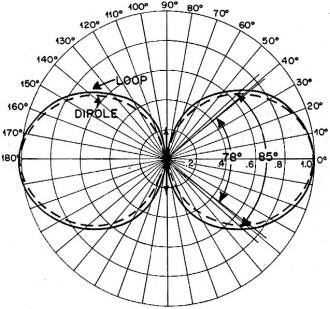
Fig. 2 - Normalized horizontal patterns for the loop and dipole
antennas, all heights. For this and all following patterns, the solid line is for
the loop.
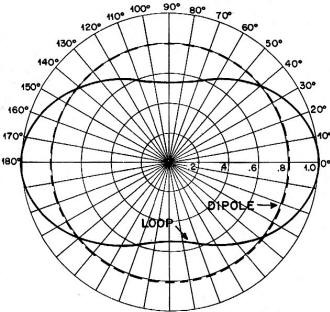
Fig. 3 - Free-space vertical patterns for both antennas. Maximum
loop gain is 1.94 dB.
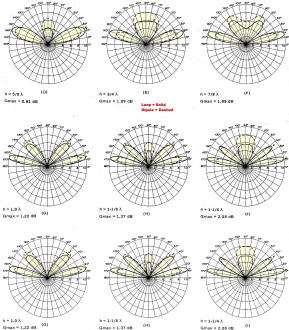
Fig. 4 - Vertical patterns and gains for the loop over the dipole
antenna at various heights above perfectly conducting ground. Loop curves are solid
lines. At low heights the gain for the loop is low and the radiation angles are
high for both antennas, but the loop is superior in every case. Substantial improvement
for the loop appears first at 3/4 λ, where its gain approaches the free-space
value and its radiation angle drops below 20° for the first time.
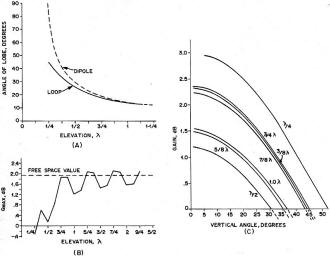
Fig. 5 - Comparisons of the performance of the loop and dipole
in several categories of interest to the amateur. The vertical angle of the lowest
lobe for the two antennas is given in A. Gain of the loop over the dipole at heights
up to 2-1/4 f... is shown in B. Gain for the loop over the dipole at vertical angles
up to 50° is given for various heights in C.
Over the years there have been many claims pro and con regarding the performance
of full-wave loop antennas. Loops in diamond, square, circular, and hexagonal shape
have been described. Unfortunately for prospective users, most of the comparisons
have not been very analytical. Relative performance claims have often been based
on differing models, assumptions, and measurement techniques. The loop's gain over
a dipole is one fact about which there is disagreement. Lindsay1 reported
2 dB, while Orr2 reports 1.4. There have been other figures in between
these two numbers.
A computer study of the loop-dipole question revealed that the disparity apparently
results from the model chosen. If the current maxima are farther apart, as in a
circular or diamond-shaped loop, the higher gain figure results. Our model attains
the 2-dB figure, since more rigorous analytical and empirical information is available
on that configuration.
Another curiosity concerns the loop's reputation as a good DX antenna. It does
not seem reasonable to attribute this to a mere 1.5 to 2 dB of gain, which is barely
distinguishable to the human ear, and Lindsay claims that the vertical angle of
radiation is "essentially the same." Having the various contradictory facts, the
authors decided to perform an analysis rigorous enough to uncover some of the misconceptions.
Information available to date has not extensively considered loops above ground,
in direct comparison with dipoles above ground. Actually this is the only situation
to consider, since with all ground-based hf antennas this is the case.
Simplified Theory
In order to model the loop antenna, only the major radiation component (horizontal)
is considered. Fig. 1 shows the model for both the full-wave loop and the half-wave
dipole. In the analysis the height above ground, H, is assumed to be that of the
geometric center of the loop elements. Ground is considered ideal.
The computer analysis proceeds as follows:
1) The current in all elements is defined.
2) The radiation field is examined point by point in all space.
3) The drive currents in all antenna elements are adjusted so that the total
radiated power from the antenna systems is equal.
4) The fields of both antennas are then plotted on the same graph for one height.
5) Other pertinent data are extracted from the field plots.
Analysis Results
The comparative horizontal patterns of the loop and dipole are shown in Fig.
2. The plot represents horizontally polarized E-field intensity only, as it varies
with azimuth angle. The loop is known to have small vertically polarized side lobes,
but all vertically polarized components were omitted from the analysis and will
not be discussed. As is apparent from the figure, the dipole has a slightly narrower
3-dB beam width approximately 78°, compared to 85° for the loop.
Fig. 3 shows the comparative free-space vertical patterns for both antennas.
The dipole has the familiar isotropic pattern, whereas the loop has a "peanut" pattern
resulting from some vertical-direction phase cancellation in the plane of the loop.
The E-field intensity amplitudes shown on the graph may be directly ratioed for
a true indication of relative power radiated at my vertical angle. For example,
if the E-field values for zero degrees are taken, the maximum power gain of the
loop over the dipole is found to be
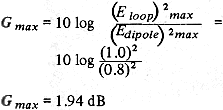
This compares favorably with the 2-dB free-space gain figure reported by Lindsay
for the circular loop, and substantiates that the simplified loop model used in
the computer analysis approximates the correct free-space performance. Theoretical
free-space conditions are interesting for examining ideal element radiation pattern
comparisons but of primary interest to amateurs operating the hf bands are the effective
patterns in the presence of ground.
Figures 4A through 41 show what happens when loops and dipoles are suspended
at various elevations above perfectly conducting earth. At a quarter-wave above
ground (Fig. 4A) the dipole radiates maximally straight up. The loop at the same
height is better, giving a peak at about 45° and radiating substantially greater
power than the dipole at lower angles. But by the standard way of comparing antenna
gains (ratio of lobe peaks) we see that the dipole radiates a slightly stronger
E-field straight up than the loop does at 45°, resulting in a loop-to-dipole
gain (Gmax) of -0.31 dB. As the elevation increases, the lobe angles
decrease and a vertical null begins to form until at λ/2 above ground (Fig.
4C) a complete vertical null exists. At this elevation there is little difference
between the peak lobe angles for either antenna (30° dipole vs. 27 loop), and
the difference becomes even less as the height increases (Figs. 4D through 4I, and
Fig. 5A). Continuing above λ/2, another vertical direction lobe forms, grows,
splits, and nulls by 1.0 λ (Fig. 4G), and this process just continues with
more height.
It is interesting to note that the Gmax loop gain over a dipole does
not become significant until 3/4 λ above ground, where it is up to 1.89 dB
(Fig. 4E). Fig. SB shows how Gmax varies with height, first nearing the
free-space figure at 3/4 λ and seesawing on up with more height. This figure
shows that the 2-dB gain of the loop over a dipole does not become available until
the elevation gets to 3/4 λ but the reputation of the loop is for exceptional
performance over a dipole especially at low elevations. This advantage does in fact
exist if one ignores the lobe peaks and compares only the absolute field intensities
radiated at each angle.
Using Figs. 4A through 4I to obtain relative field intensities radiated at various
vertical angles, we get the set of curves plotted in Fig. 5C. At an elevation of
only λ/4 it is evident that up to 3-dB more power is radiated at low angles
by the loop than by the dipole. The reader is cautioned that this curve says nothing
about where the lobe peaks are, but merely gives an indication of how much power
the loop radiates at any specific vertical angle relative to a dipole at the same
height. Heights of 3/8 λ, 3/4 λ, and 7/8 λ are also seen to be good
for maximizing the low-angle advantage of the loop, whereas at λ/2, 5/8 λ,
and 1.0 λ the gain is small but still significant.
As the figures have shown, the comparative performance of a loop vs. a dipole
can vary rather widely with elevation. As every frustrated antenna engineer knows,
the effective elevation of any antenna in the presence of objects such as houses,
trees and power lines, and with varying ground conductivity, can be quite different
from physical elevation. The most significant conclusion that can be drawn is that
effective elevation is likely to differ from the physical height. Therefore, it
would be a mistake for the amateur to place too much emphasis on achieving a precise
elevation to realize a specific vertical pattern, unless true ground is known.
Conclusions
With real-world exceptions as they are, it is nevertheless possible to draw several
meaningful general conclusions from the theoretical curves that have been presented
here:
1) A full-wave loop antenna has a low-angle advantage over a dipole at all elevations.
It is therefore a more effective DX antenna.
2) At angles below 10° the gain of the loop over the dipole never goes below
1.0 dB and may range up to 3 dB.
3) If the effective ground elevation of a particular installation is known with
confidence, it may be predicted that λ/2 is particularly bad elevation for
a loop in terms of advantage over a dipole.
4) The loop has a slightly broader horizontal pattern, but the difference is
so small to be of little significance.
5) The vertical lobe peak angles are substantially different up to λ/2 height,
and track closely at higher elevations .
Unsubstantiated (But Probably True) Observations
1) In all real-world situations, the loop is somewhat unbalanced between top
and bottom currents which causes the vertically polarized components of radiation
to be greater.
2) This vertically polarized component may be a substantial reason for the loop's
added advantage, especially during periods of marginal band conditions.
3) Two vertically stacked half-wave dipoles have the potential to out-perform
the loop.
4) A one-wavelength horizontally polarized loop may have more gain in the diamond
configuration than in the square. This is due to the current centers being separated
by different distances and could account for the diversity of gains reported. Perhaps
some interested reader would care to analyze this possibility further.
Detailed Theory
The horizontal electric field intensity E(Θ Φ) can be defined by the methods
in step 4 of the computer analysis as
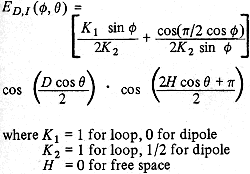
where K1 = 1 for loop, 0 for dipole
K2 = 1 for loop, 1/2 for dipole
H = 0 for free space
The equation is valid for both the loop and dipole antenna. Note from the model
that H>D/2 in order to keep the bottom loop element above ground. D is 0.318λ
to approximate Lindsay's model.
After calculating the electric field intensity at all points in a 1/8 sphere,
the total radiated power is computed for each case at unit radius and unit space
impedance, since the ratio of the absolute power is important.

The field intensity is then normalized by the expression

For ease of plotting, all field intensities are again normalized to a maximum
value of 1.0.
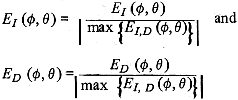
The gain of the loop over the dipole can then be expressed as

Footnotes
1 This and subsequent footnotes will appear on page 37.
1 Lindsay "Quads and Yagis," QST for May, 1968.
2 Orr, "Antennas," CQ for January, 1974. Orr, All About Cubical Quad
Antennas, Radio Publications, Inc., second edition, 1971, p. 16. Kraus, Antennas,
McGraw Hill Book Co., 1950.
Posted August 7, 2020
|



















